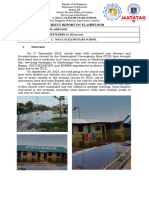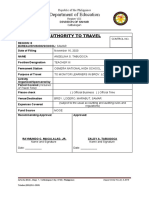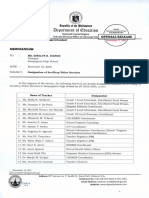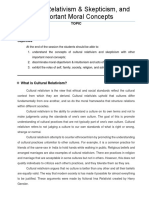October 2022 - SAGIP Narative Report
October 2022 - SAGIP Narative Report
Uploaded by
ANGELICA AGUNODCopyright:
Available Formats
October 2022 - SAGIP Narative Report
October 2022 - SAGIP Narative Report
Uploaded by
ANGELICA AGUNODOriginal Description:
Original Title
Copyright
Available Formats
Share this document
Did you find this document useful?
Is this content inappropriate?
Copyright:
Available Formats
October 2022 - SAGIP Narative Report
October 2022 - SAGIP Narative Report
Uploaded by
ANGELICA AGUNODCopyright:
Available Formats
Republic of the Philippines
Department of Education
National Capital Region
Schools Division Office of Caloocan City
Sampaguita High School
11th Paraiso St. Sampaguita Subd. Camarin, Caloocan City
Susi sa Angking Galing ng Indibidwal ay Pagbasa (SAGIP)
NARRATIVE REPORT
S.Y. 2022-2023
I. Title:
Phil-IRI Group Screening Test in Filipino
II. Date and Time:
September 19-23, 2022
Filipino Class Hours
III. Venue:
Classroom
IV. Participants:
Filipino Teachers
Grade 7-10 students
V. Objective/s:
to conduct a silently administered reading test for Filipino
to identify students who need further testing in reading
VI. Narrative:
Following the schedule given by the SDO Caloocan City, the first stage of the Phil-IRI
Reading Assessment which is the Group Screening Test (GST), was conducted last September
19-23, 2022. The GST is a silently administered test in Filipino. Each tool is composed of a 20-
item comprehension test based on a set of leveled passages for each grade level covering
Grades 7-10 in Filipino. The passages were written and selected based on concept load, level of
vocabulary used, sentence complexity, nature of themes, and cohesion. The objective of the
GST is to identify students who need further testing.
Before the actual implementation of GST, SDO Caloocan City already provided the
schools, including Sampaguita High School, with the GST reading materials for Grades 7-10
which were then printed. It was also reminded that the GST will be conducted from September
19-23, 2022 only and it has to be done within Filipino class hours. Filipino teachers facilitated
the GST in their classes, and they are the ones who oriented their students about it. The
administration process of the GST includes the following steps:
The GST will be conducted during Filipino class hours.
Teachers will provide the students with a hard copy of the reading text and 20-item
questions.
Students will be given 30 minutes to read the text and answer the questions on a ¼
paper.
Students will check their papers right away after the given time.
The scores of the students will be recorded by the teacher on the score sheet.
Teachers will then encode the students’ scores on the centralized database given by the
Reading Coordinator.
After one week of administration of GST and encoding of grades, essential results were
generated. Based on the results, a total of 2,725 students were able to answer the GST, and
that is 93.80% of 2,905 school’s total enrollment. There were 629 students from Grade 7, 674
students from Grade 8, 715 students from Grade 9, and 707 students from Grade 10 who took
the test. The results are reflected in Figure 1:
Address: 11th Paraiso St. Sampaguita Subd. Camarin, Caloocan City
Telephone No.: 441-2907
Email Address: sampaguita_hs@yahoo.com
Website: @sampaguitahsofficial
Republic of the Philippines
Department of Education
National Capital Region
Schools Division Office of Caloocan City
Sampaguita High School
11th Paraiso St. Sampaguita Subd. Camarin, Caloocan City
800
767 753
700 703 715 707
682 674
629
600
500
400
300
200
100
0
Grade 7 Grade 8 Grade 9 Grade 10
Total DO Enrollment Record Number of Students who took the GST
Figure 1: Comparison of Total DO Enrollment Record and Number of Students who took the GST
From these, we were able to identify the number of students who passed and failed the
GST. From a total of 2, 725 test takers, only 1,733 students passed the test. This draws a
63.59% passing rate. The breakdown of number of students who passed and failed is shown in
Figure 2.
700
689
600
500 496 495
400 416
300
258
200 220
133
100
18
0
Grade 7 Grade 8 Grade 9 Grade 10
PASSED FAILED
Figure 2: Comparison of Total Number of Students who Passed and Failed the GST per Grade Level
The results obtained from the administration of the GST will be used as the basis for
the determination of students who will undergo further testing during the Stage 2 of Phil-IRI.
Address: 11th Paraiso St. Sampaguita Subd. Camarin, Caloocan City
Telephone No.: 441-2907
Email Address: sampaguita_hs@yahoo.com
Website: @sampaguitahsofficial
Republic of the Philippines
Department of Education
National Capital Region
Schools Division Office of Caloocan City
Sampaguita High School
11th Paraiso St. Sampaguita Subd. Camarin, Caloocan City
VII. Documented Pictures:
Administration of Phil-IRI Group Screening Test among Grade 7 learners
Administration of Phil-IRI Group Screening Test among Grade 8 learners
Administration of Phil-IRI Group Screening Test among Grade 9 learners
Administration of Phil-IRI Group Screening Test among Grade 10 learners
Address: 11th Paraiso St. Sampaguita Subd. Camarin, Caloocan City
Telephone No.: 441-2907
Email Address: sampaguita_hs@yahoo.com
Website: @sampaguitahsofficial
Republic of the Philippines
Department of Education
National Capital Region
Schools Division Office of Caloocan City
Sampaguita High School
11th Paraiso St. Sampaguita Subd. Camarin, Caloocan City
Prepared and submitted by:
ANGELICA D. AGUNOD
Teacher I, SAGIP Coordinator
Submitted to:
MARIA TERESA D. MACARANAS
Head Teacher III, Filipino Department
Noted by:
GINALYN B. DIGNOS, EdD
Principal IV
Address: 11th Paraiso St. Sampaguita Subd. Camarin, Caloocan City
Telephone No.: 441-2907
Email Address: sampaguita_hs@yahoo.com
Website: @sampaguitahsofficial
Republic of the Philippines
Department of Education
National Capital Region
Schools Division Office of Caloocan City
Sampaguita High School
11th Paraiso St. Sampaguita Subd. Camarin, Caloocan City
Susi sa Angking Galing ng Indibidwal ay Pagbasa (SAGIP)
NARRATIVE REPORT
S.Y. 2022-2023
I. Title:
Individualized Phil-IRI Assessment: Oral Reading Test in Filipino
II. Date and Time:
September 26-30, 2022
Filipino Class Hours
III. Venue:
Classroom
IV. Participants:
Filipino Teachers
Grade 7-10 students
V. Objective/s:
to conduct a silently administered reading test for Filipino
to identify students who need further testing in reading
VI. Narrative:
In compliance with the SDO Caloocan Memorandum No. 433, s. 2022, the Stage 2 of
Phil-IRI implementation called as the Individualized Assessment or Oral Reading Test was
conducted last September 26-30, 2022. The activity was spearheaded by the SAGIP
Coordinator, Ms. Angelica D. Agunod through the guidance of the Filipino Department
Head, Mrs. Maria Teresa D. Macaranas.
The Phil-IRI Individual Assessment Tool (IAT) can describe the kind of material that the
child is able to perform well in and or has difficulty with. Alongside with it, it can be used
to assess the oral reading skills of the students in terms of decoding and word recognition,
fluency, and comprehension.
For the administration of the ORT, materials were first prepared by each grade level
teachers. The materials included the Phil-IRI Graded Passages and questions from the
Phil-IRI manual, template for summary of miscues, score sheets, parents’ permit, and the
list of students to be assessed. Unlike the GST, which was administered in group, the ORT
had to be done individually since it required the oral reading of the students, reel time
recording of the students’ miscues and timing the students’ reading speed. The steps of the
ORT administration are as follows:
Based on the data of GST, the Reading Coordinator will inform the Filipino
teachers who among their students got a score lower than 14 and will undergo
the Oral Test.
The Oral Test may be conducted during class hours (given that discussions will
not be interrupted, or teachers will give the class with activities), or before/after
class hours (given that teachers will secure a permit from the parents.)
Teachers will be given the Oral Test Result Form where they will record the
miscues exhibited by the students, their total reading time, and the
comprehension test scores.
The Oral Test should be done on a one-on-one basis, so teachers have the
discretion of scheduling their students.
Address: 11th Paraiso St. Sampaguita Subd. Camarin, Caloocan City
Telephone No.: 441-2907
Email Address: sampaguita_hs@yahoo.com
Website: @sampaguitahsofficial
Republic of the Philippines
Department of Education
National Capital Region
Schools Division Office of Caloocan City
Sampaguita High School
11th Paraiso St. Sampaguita Subd. Camarin, Caloocan City
After the consolidation of all the data, the oral reading level of the students were
identified if they are in independent, instructional, or frustration level. Based on the gathered
data, there were a total of 992 students who had the ORT, 496 (53.80%) students from Grade
7, 258 (26%) students from Grade 8, 220 (22.18%) students from Grade 9 and 18 (1.8%)
students from Grade 10. Among these 992 students, 567 (57.16%) students were in
independent level, 356 (35.89%) students were in instructional level, and 69 (7%) students
were in frustration level. The encoded data for the ORT for each section ang grade level can be
accessed in this link: The summary of the ORT results can be reflected in Figure 1:
300
251
250
203
200
165
150 134
106
100
42 46
50
18 17
9
1 0
0
Grade 7 Grade 8 Grade 9 Grade 10
Independent Instructional Frustration
Figure 1: Number of Students per Reading Level for each Grade Level
After validating the data and results, all students who had the oral reading level of
frustration are extracted. These students will be the one who will attend the 20 sessions of
reading intervention class every Thursday as part of the Stage 3 of the Phil-IRI Implementation
which is the Provision of Specialized Instruction/Intervention. From the 992 students who had
the ORT, 69 students who had the frustration level were identified to be the participant of the
Reading Intervention Classes. The list of these students can be seen in the Table 1:
Address: 11th Paraiso St. Sampaguita Subd. Camarin, Caloocan City
Telephone No.: 441-2907
Email Address: sampaguita_hs@yahoo.com
Website: @sampaguitahsofficial
You might also like
- Action Plan School Elementary Learning Government SelgDocument2 pagesAction Plan School Elementary Learning Government SelgMYRA ASEGURADO100% (6)
- Parent Teacher Election Narrative ReportDocument2 pagesParent Teacher Election Narrative ReportAngelica Dongque Agunod100% (4)
- Parent Teacher Conference Narrative ReportDocument4 pagesParent Teacher Conference Narrative ReportAngelica Dongque Agunod100% (3)
- September 2022 - SAGIP Narative ReportDocument4 pagesSeptember 2022 - SAGIP Narative ReportANGELICA AGUNODNo ratings yet
- Summit LetterDocument1 pageSummit LetterAriane Grace LopezNo ratings yet
- Lesson Plan MonitoringDocument6 pagesLesson Plan MonitoringMa'am Sandra Marie GarciaNo ratings yet
- EnrollmentDocument2 pagesEnrollmentJen-Jen L. ElonaNo ratings yet
- Assessment AcrDocument5 pagesAssessment AcrShaina MancolNo ratings yet
- Pta Attendance SheetDocument2 pagesPta Attendance SheetEden Joy Castro RallecaNo ratings yet
- Department of Education: Republic of The PhilippinesDocument2 pagesDepartment of Education: Republic of The PhilippinesJanelyn BayanNo ratings yet
- SSC - Teachers MonthDocument5 pagesSSC - Teachers Monthnuria mukaraniNo ratings yet
- SJPNHS-La Purisima Accomplishment (June-December 2020)Document39 pagesSJPNHS-La Purisima Accomplishment (June-December 2020)Charlene BorladoNo ratings yet
- Phil IRI Narrative ReportDocument1 pagePhil IRI Narrative ReportMithz SuneNo ratings yet
- Incident Report Flood-Sep 25 2023Document33 pagesIncident Report Flood-Sep 25 2023Margie MejiaNo ratings yet
- Brigada Eskwela Brigada Pagbasa Narrative ReportDocument7 pagesBrigada Eskwela Brigada Pagbasa Narrative ReportAngelica Dongque Agunod100% (2)
- Assessment ResultDocument2 pagesAssessment ResultIRISH ANNE MARAMAGNo ratings yet
- Learning Activity Sheets LAS 1Document2 pagesLearning Activity Sheets LAS 1Timotheus ZenNo ratings yet
- Iluiltililililiilruruuillilttil$Ffi (: MicrosoftDocument5 pagesIluiltililililiilruruuillilttil$Ffi (: MicrosoftBernadette BulawanNo ratings yet
- Incident ReportDocument1 pageIncident ReportMichael LorenzoNo ratings yet
- Minutes Format - Election of OfficersDocument5 pagesMinutes Format - Election of OfficersJenicaEilynNo ratings yet
- Attendance Releasing of BooksDocument2 pagesAttendance Releasing of BooksAbigail DescartinNo ratings yet
- Certificate of Merit and Recognition: Dominga B. RamirezDocument1 pageCertificate of Merit and Recognition: Dominga B. RamirezDominga RamirezNo ratings yet
- Project Profile: Department of EducationDocument3 pagesProject Profile: Department of EducationBeejay TaguinodNo ratings yet
- ANGELYNDocument19 pagesANGELYNAngelo GarciaNo ratings yet
- Acr Intramurals FinalDocument8 pagesAcr Intramurals FinalO Jenra K EithNo ratings yet
- Resolution NO. 4 S. 2022 2023Document3 pagesResolution NO. 4 S. 2022 2023Mary Jade AninonNo ratings yet
- Department of Education: Authority To TravelDocument3 pagesDepartment of Education: Authority To TravelZaldy Tabugoca100% (1)
- ACR-Work Immersion SY 2021-2022Document2 pagesACR-Work Immersion SY 2021-2022JAKE ANTHONY MAJADILLASNo ratings yet
- PAWIM F 018 Attendance Sheet - NLCA - PostTest RepairedDocument1 pagePAWIM F 018 Attendance Sheet - NLCA - PostTest RepairedJohn Rusty FiguracionNo ratings yet
- Certificate of Completion: Khevin S. AlvaradoDocument16 pagesCertificate of Completion: Khevin S. AlvaradoDennis DesabilleNo ratings yet
- School Memo No. 15 S. 2018 DATE: September 5, 2018Document10 pagesSchool Memo No. 15 S. 2018 DATE: September 5, 2018Winston CelestialNo ratings yet
- Narrative On The Status ADMDocument10 pagesNarrative On The Status ADMPancake Binge&BiteNo ratings yet
- YES-O ACTION PLAN1 Learners Material InventoryDocument17 pagesYES-O ACTION PLAN1 Learners Material Inventoryconnie d. julianNo ratings yet
- Project CleanDocument2 pagesProject Cleanalex dela vegaNo ratings yet
- Minutes For Homeroom MeetingDocument10 pagesMinutes For Homeroom MeetingWinston GavilagaNo ratings yet
- Sergia Soriano Esteban Integrated School of Kalaklan-SpedcDocument2 pagesSergia Soriano Esteban Integrated School of Kalaklan-SpedcVenus Kay Faderog LptNo ratings yet
- CERTIFICATEDocument1 pageCERTIFICATEJudy May FernandoNo ratings yet
- Certificate of Recognition - 2nd QuarterDocument3 pagesCertificate of Recognition - 2nd QuarterJessy EbitNo ratings yet
- Certificate of Recognition - 2nd QuarterDocument3 pagesCertificate of Recognition - 2nd QuarterJessy EbitNo ratings yet
- Certificate of Recognition - 2nd QuarterDocument3 pagesCertificate of Recognition - 2nd QuarterJessy EbitNo ratings yet
- FINAL RCES Good MoralDocument2 pagesFINAL RCES Good MoralRuby MacasinagNo ratings yet
- Certificates Benchmarking 1Document4 pagesCertificates Benchmarking 1Joshua JoshuaNo ratings yet
- Minutes For Homeroom MeetingDocument10 pagesMinutes For Homeroom Meetingglydel.pototNo ratings yet
- RPMS 2024 CoverDocument10 pagesRPMS 2024 Covergwendolynsue8No ratings yet
- Work Immersion Implementation Plan - Pulo EIMDocument20 pagesWork Immersion Implementation Plan - Pulo EIMcristina.mfr.maquintoNo ratings yet
- Sample Letter of Request For Guest-SpeakerDocument1 pageSample Letter of Request For Guest-Speakervioleta sagun50% (2)
- Department of Education: June 7-11, 2021Document3 pagesDepartment of Education: June 7-11, 202112001688300No ratings yet
- LAC Session Evaluation ToolDocument3 pagesLAC Session Evaluation ToolGLORYBELLE CAINTOYNo ratings yet
- Certificate of ParticipationDocument1 pageCertificate of ParticipationLeonisa V. BraganzaNo ratings yet
- Certificate of ParticipationDocument1 pageCertificate of ParticipationLeonisa V. BraganzaNo ratings yet
- School Template (F4-Portrait)Document19 pagesSchool Template (F4-Portrait)Gretchelle Obnimaga SeñoNo ratings yet
- Front Page TP 2Document18 pagesFront Page TP 2Katrina MalicdemNo ratings yet
- Christopher Eric Labadia Abejar: Certificate of ParticipationDocument2 pagesChristopher Eric Labadia Abejar: Certificate of Participationmontesa anteNo ratings yet
- Graduation Activity DesignDocument4 pagesGraduation Activity DesignHeidy Tabinas Soria Garma100% (1)
- CertificationDocument11 pagesCertificationnylxyxzy0411 albNo ratings yet
- Certificate of Recognition: Villarica High SchoolDocument13 pagesCertificate of Recognition: Villarica High SchoolJosephine MeguisoNo ratings yet
- Budget Proposal Shirt PrintingDocument5 pagesBudget Proposal Shirt PrintingFatima MangadangNo ratings yet
- SF10 RequestDocument2 pagesSF10 RequestAnthony Sadang Gonzales (Lunduyan 2)No ratings yet
- Graduation - LetterDocument16 pagesGraduation - LetterANGELIE CRISTINE POMADONo ratings yet
- Ref. No. 22 644 S. 2022 Designation of Ancillary Other ServicesDocument3 pagesRef. No. 22 644 S. 2022 Designation of Ancillary Other ServicesANGELICA AGUNODNo ratings yet
- Impression SpeechDocument2 pagesImpression SpeechANGELICA AGUNOD100% (1)
- WK 2 ETH 101Document6 pagesWK 2 ETH 101ANGELICA AGUNODNo ratings yet
- Wks 5 & 6 ETH 101Document7 pagesWks 5 & 6 ETH 101ANGELICA AGUNODNo ratings yet
- Sagip Action Plan Sy2022-2023Document7 pagesSagip Action Plan Sy2022-2023ANGELICA AGUNODNo ratings yet
- Wks 7 & 8 ETH 101Document13 pagesWks 7 & 8 ETH 101ANGELICA AGUNODNo ratings yet
- Reading Space - PROJECT PROPOSALDocument2 pagesReading Space - PROJECT PROPOSALANGELICA AGUNODNo ratings yet
- Brigada Eskwela Narrative Report - AGUNODDocument5 pagesBrigada Eskwela Narrative Report - AGUNODANGELICA AGUNODNo ratings yet
- Brigada Eskwela 2018 Jingle LyricsDocument2 pagesBrigada Eskwela 2018 Jingle LyricsANGELICA AGUNODNo ratings yet
- Letter To Intent (SCA)Document3 pagesLetter To Intent (SCA)ANGELICA AGUNODNo ratings yet





































































